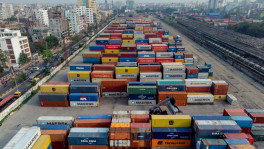Import surge drives up nine-month trade deficit to $25b
Exports clocked the $4 billion mark in April for the eight consecutive month posting 51% year-on-year growth
The country's trade deficit is growing sharply owing to a massive increase in imports compared to exports and the rise in prices of all kinds of products such as food items and fuels in the world market.
In the first nine months of fiscal 2021-2022, the trade deficit was about $25 billion which was 9.25% higher than that of the full period of the previous fiscal year. The deficit is around 64% more than the July-March period.
The trade deficit for the nine months of fiscal 2020-21 was $15.28 billion while it stood at $22.80 billion for the entire fiscal year.
In April, the exports clocked the $4 billion mark with 51% year-on-year growth, raking in $43.34 billion in 10 months of the current fiscal year, according to unofficial data from the Export Promotion Bureau.
Import figures for April are not available, but the growth trend so far seen in previous months points to further widening of the trade deficit.
Due to the huge trade deficit in the current financial year, Bangladesh has also plunged into a large deficit in the current account balance of foreign transactions.

During the July-March period, the deficit rose to $14.7 billion. At the same time previous fiscal year, this important indicator of Bangladesh's economy had a deficit of only $555 million.
Economists say a sharp rise in imports has led to a massive increase in the deficits of trade and transactions. However, to keep the country's economy normal, imports have to be restricted. Otherwise, the economy will fall into a crisis.
Imports have been on the rise since the Covid-19 pandemic eased. And the gap between import and export or trade deficit is increasing.
The data released by the Bangladesh Bank on Sunday updated the current account balance of foreign transactions, showing that Bangladesh imported a variety of goods worth $61.52 billion during the July-March period of fiscal 2021-22. This is 43.86% more than the same period of the previous fiscal year. In the first nine months of fiscal 2020-21, goods worth $42.76 billion were imported.
On the other hand, during the July-March period of the current financial year, exporters earned $36.61 billion by shipping various products, which is 32.92% more than the same period of the previous fiscal year.
As a result, the overall trade deficit stood at $24.91 billion in the first nine months of the fiscal year.
Meanwhile, the current account deficit surpassed $14 billion. The financial year 2021-22 started with a deficit in the balance of transactions.
In the first three months through September, the deficit was $2.31 billion. At the end of four months – in the July-October period – it rose to $4.76 billion. The deficit during the July-November period was $6.22 billion.
At the end of December, it rose to more than $8 billion. At the end of January, it reached $10.19 billion.
At the end of February, it rose to $12.83 billion. At the end of last March, it reached a peak of $14.07 billion. Bangladesh has never faced such a large deficit in any previous financial year.
Fiscal 2020-21 ended with a large surplus of $9.27 billion thanks to the reduction in imports amid the pandemic. In the previous fiscal year, the surplus was $3.169 billion.
However, the country's financial account is still in surplus. During the July-March period, the surplus stood at $11.34 billion. At this time in the last fiscal year, there was a surplus of $7.95 billion.
According to economists, the surplus has been driven by financial assistance from the World Bank, International Monetary Fund, Asian Development Bank and other donor countries and agencies to offset the pandemic blues.
According to the data, during the July-March period of the current financial year, Bangladesh received loan assistance of $6.80 billion from various donor countries and organisations, which is $55.16$ more than the same period of the previous fiscal year.
In these nine months of the fiscal 2020-21, Bangladesh received loan assistance of $4.38 billion.
Meanwhile, expatriates sent remittances worth $15.30 billion during the July-March period. This figure is 17.74% less than the same period of the previous financial year. During the same period of FY21, remittances of $18.60 billion arrived in the country.
After Covid, the demand for all kinds of products has increased in the country. Besides, the prices of products in the world market were increasing sharply. Prices are rising further as supplies have been disrupted by the recent Russia-Ukraine war.
In April last year, the price of fuel oil in the international market was $60 per barrel. The same oil sold for more than $112 on Sunday. It rose to $139 at the start of the Russia-Ukraine war.
April exports post 51% growth
Bangladesh's export earnings have almost reached its export target amounting to 43.5 billion set for FY22 in 10 months, thanks to growing global demand for apparels and shifting of a good number of work orders from China.

In April, the exports clocked the $4 billion mark for the eighth consecutive month with a little over 51% year-on-year growth.
In July-April, the country raked in $43.34 billion in exports with the readymade garment sector having been the major contributor as usual – it alone accounts for more than 81%, according to sources at the Export Promotion Bureau (EPB).
Dr Khondaker Golam Moazzem, research director at the Centre for Policy Dialogue (CPD), told The Business Standard the trade deficit is not just a Bangladesh-centric phenomenon, it has been in other developing countries as well. Where both current account and trade balance deficit are increasing.
"This is mainly due to higher import costs and lower export growth. The reason for the increase in import costs is that commodities and petroleum have to be imported at higher prices. Although remittances played a good role last year, it is comparatively less this year. That has also affected the overall balance," he added.
The CPD research director further said that the current account and trade balance are being affected by the globalised turmoil in trade.
"However, the amount of reserves we have is still at a tolerable level. But if this rate of imports continues, the reserves will also decrease over time. Now we need to reduce import costs," he added.
In this case, he said, the government should limit the import of non-essential products although the Bangladesh Bank has already asked for keeping a 25% margin for opening letters of credit (LCs).
"Additionally, it is necessary to increase the value of the dollar by further devaluating the taka. At the same time, foreign loans can be received at low-interest rates," he added.


 Keep updated, follow The Business Standard's Google news channel
Keep updated, follow The Business Standard's Google news channel
















